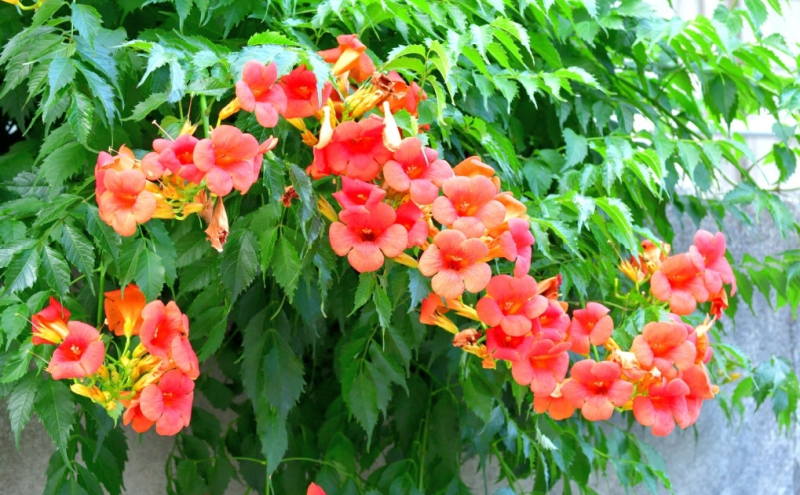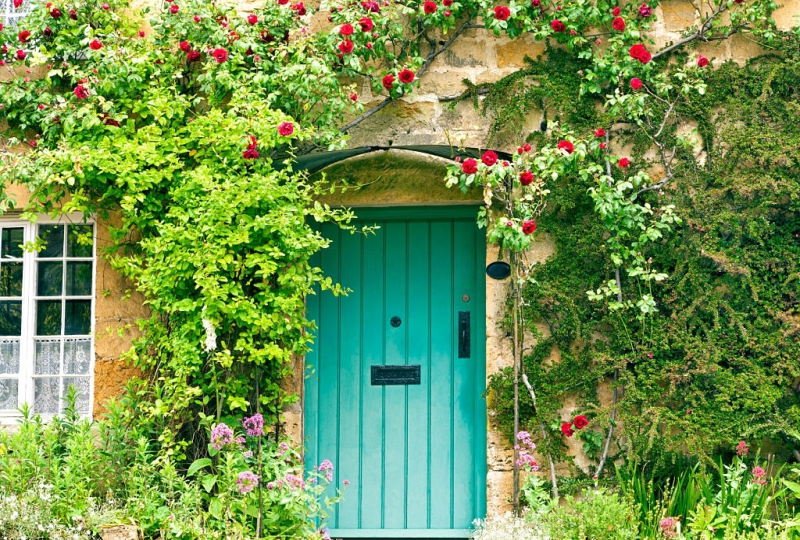Climbing plants are an interesting way to arrange any room in any way. With their small help we can create a unique decor for a balcony, terrace or even a house. They are suitable for planting in the garden. They can be plants for the summer or for the whole season. Depending on their use, climbing plants can form a background for a composition of standing flowers (for this purpose, among other things, a net, ladder or hanging pots will be useful). Sometimes they are an independent decoration of the space, for example, a balcony.
Compilation of decorative climbing plants will allow you to choose a particular species and arrangement of hanging plants. We will focus on climbing plants for summer, perennial plants, evergreen plants, shade-loving plants and red flowering plants, etc. We encourage you to read our article.
Flowering evergreen vines
This is a remarkable patent for creating a green background for a dilapidated wall or fence. Under the evergreen vine will hide any deficiency of the facade or wall. evergreen vines are an interesting decoration of fence nets. Plants of this type can be green for several seasons. Some of them bloom for the summer. Here are some evergreen vines that are worth considering. Due to different temperature ranges, we can’t give guarantees that evergreen vines will withstand frost. Among the many species of plants, we have selected the most interesting varieties that perform three important functions. They are perennial, flowering and can withstand minus temperatures. Here are some examples:

- Climbing hydrangea – Hydrangea anomala subsp. petiolaris
A type of climber with round, green leaves. In autumn they turn yellow. Placed on adventitious shoots can grow from 5 to 10 meters. The width of the evergreen composition can be from 3-4 meters. Inflorescences of white, slightly creamy color form clusters in the form of a flat canopy. The petals of the flowers by their appearance refer to 3-4 leaf clover. Flowering takes place from June to July.
The climbing hydrangea is resistant to frosts reaching up to -29 degrees Celsius. It grows on average and loamy soils. It can grow in slightly acidic and moist soils pH 5,5-6,5. The plant is adapted to shade or semi-shaded positions.
- Colchis ivy ‘Dentata Variegata’
This is a kind of climber with interesting leaf coloration. Kolchida ivy has green leaves with a characteristic whitish border. It reaches a height of up to 10 meters. Ivy can spread up to 3 meters. The heart-shaped leaf with an irregular edge is attached to the pituitary stem. The evergreen vine has white or cream-colored flowers. The inflorescence is arranged in a characteristic rhizome. Flowering takes place from September to October.
Evergreen ivy vines like alkaline soil pH 7,2-7,5.The plant is resistant to frosts up to -18 degrees Celsius. The substrate for ivy can be standard or loamy. Ivy likes moisture. Vines are plants for shade.
Climbers for the balcony
Plants for the balcony must follow several important rules. One of them is low growth. Due to limited space, plants must be undercut. Perennial vines that respond well to pruning shears will be ideal balcony plants. Often climbers need to be moved, for example, to basements, apartments. Multipurpose plants that we can rearrange for shade, sunny rooms that like rearrangement can be interesting species for the balcony. The same applies to seasonal plants, for example, for summer. Here are some examples of species worthy of attention.
- Wilec (Ipomea)
These are vines that bloom in red, blue, white, purple or pink. The cup-shaped flowers appear between July and September. Leaves of heart-shaped structure with a characteristic petiole. The growth reaches a width of up to 3 meters.
Willow likes sites with high humidity. It tolerates drought badly, so be sure to water it. Garden climbers like sunny positions.
- Clematis
These are vines ideal for the balcony. Some of the varieties Mrs. N. Thompson’, ‘Multi Blue’ or ‘Niobe’ reach a maximum height of 1.5 meters. The width of the plants for the summer can reach up to a maximum of 2 meters, which is very functional, since balconies usually reach this height. The doubler, depending on the variety, has vines flowering in red (Niobe), purple (Mrs. N. Thompson) or blue (Multi Blue). There is no shortage of flowers in white, pink or white-pink. Flowers appear around May to August. The flower structure consists of teardrop-shaped petals arranged in the form of a star. The shape of a traveling teardrop is also assumed by the leaves.
The doublofen likes sunny or gently semi-shaded positions. It needs sandy, moderate or loamy soil. More important in this case is the pH at 6.5-7.2 (neutral reaction). Caring for the vines of the doublofen, you need to remember to water, as it likes moist soil. As for frost resistance, garden vines will survive temperatures of -34 degrees Celsius.
Vines for the terrace
For a standing terrace we can plant practically any climber. Here are two types that will allow us to enjoy the terrace from spring to autumn.
- Five-leaf acebia
The garden climber reaches up to 10 meters in height and 2 meters in width. The stiff green leaves form a kind of flat umbrella. Purple flowers consist of 3 petals with characteristic stamens. Flowering is in the period of May. Semi-evergreen plant likes shady or semi-shaded positions. It accepts fertile, average and loamy soils with a pH of 6.5-7.2. It can withstand frosts of -23 degrees.
- Mottled actinidia ‘Dr. Szymanowski’
It is a shrub reaching up to 5 meters high and 2 meters wide. It has egg-shaped leaves with a characteristic white-pink coloration. It blooms in May, to a creamy color. The plant likes sunny positions. It can withstand frosts up to -34 degrees. It likes moderate, moist soil with a pH of 6,5-7,2.

Vines for the house – arrangements
Garden plants in the form of decorative climbing plants are the ideal solution for creating your own conservatory at home or on the balcony. Using climbing plants in the apartment, you may get the impression that they are much more difficult to arrange than standard potted plants. Nothing could be further from the truth. With the help of several interesting types of flowerbeds or pots, you can create an interesting decoration of the space.
- Horizontal flowerbeds
This is a type of frame with attached stands. They are suitable for plants that do not require the use of special supports. This type of solution consists of a frame, the stands of which are located at any 3 heights. There are models with 5 differently positioned stands. Flower pots for climbing plants are most often made of metal. There is no shortage of pots, where the workmanship can be made of wood or wicker.
- Coasters made of string
These are braided baskets made of strong string. You can hang potted plants and climbing plants in them. Because of the use of twine, it is worth using coasters at home. When you want to put them out on the balcony it is worth remembering to remove them in case of a storm or strong wind. Before hanging the pots, it is worth equipping yourself with suitable hooks. On the market you will find models of saucers in the form of fashionable macramé patterns. Their color scheme refers to light beige or cream.
- Netting for climbing plants
Some of the plants require a solid support. To ensure it, we can reach for garden nets. This is a square type of netting usually made of metal. They can be made of natural materials, i.e. jute. For climbing plants, wooden nets with a transverse truss are used. This type can combine with a square wooden pot.
How to care for climbing plants?
Immediately after planting a vine it is necessary to water it regularly. For two years it is necessary to take care of proper watering. After two years, water the plants during the dry season.
In order for plants to enjoy beautiful flowers for the summer, it is worth fertilizing them with a layer of compost 10kg/m3 or a compound fertilizer.
Dead shoots are cut off in the spring. The oldest shoots also need pruning. Vines that interfere with our enjoyment of the view outside the window, encroach on our neighbor’s property or may damage telephone wires require pruning – right after flowering or in early spring.
For the winter, it is worth covering vines with a straw mat or sprinkling them with a 30 cm mound of earth. The exceptions are evergreen plants.

